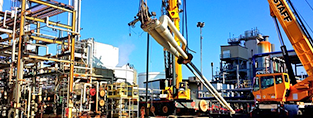
- (03) 5909 8218
- enquiry@fusionweld.com.au
Static Grounding Practices and Standards
December 3, 2014

Safety is the largest concern in the oil and gas industry. Consider an oil facility as a sublimely managed mass of metal that processes explosive chemicals. That structure is a Class One environment, a place where ignitable liquids and explosive fumes are a constant threat. When this scene is combined with the threat of electrical discharge, design engineers are left with a quandary, the problem of coming up with defences built to bend electricity to their will.
Oil refineries and offshore drilling rigs are, by their very nature, frameworks of metal, electrically-conductive alloys that create cathodic reactions. A large enough potential difference within one of these monolithic structures can transform an already hazardous area into a natural lightning rod. Now, while this situation is seen across the world, is responsible for cancelling sports events and sending kids scurrying under their beds, it requires a more potent solution on large structures. Tall buildings fit lightning rods up top, bonding the structure all the way to the ground, thus allowing the charge of a lightning strike to flow to earth. This is an example of basic electrostatics at work, as delivered by a temperamental Mother Nature. Consider the same scenario on a similar scale, on the exposed vessels and masses of pipes on an oil refinery. The same bonding and grounding must be effected because lightning protection is the oil industries lifeline against electrostatic phenomena.
Let's change tack for a moment and solicit the aid of international statistics in illustrating a major issue, that of the possible ignition of fuels stored in vessels and piping. Between 10 and 15 fires breakout on oil structures every year. The incidents range from minor ignition events to full-out tank fires. Approximately one third of these potentially tragic events are caused by lightning strikes. This is why bonding and grounding practices channel the current away from reservoirs of fuel, bypassing the stages of the oil refining process where ignition threats are highest. This involves compliance with IEEE regulations and country-specific codes of safety. For example, BS 6651 is a guide for British engineers whereas the NZS/AS 1768 instructs Australia's professionals on how to design an active rod design that attracts the lightning and disperses the high voltage strike through a grid of copper or steel to an array of buried metal.
Shunting this charge takes rigorous planning. The lightning rod is positioned at the highest point to intercept a strike. Now comes the hard part. Every exposed piece of metal on the acres-wide structure must be bonded, connected to the network of grounding straps to ensure they retain the same electrical potential. Flexible bonding conductors, expertly welded joints, mechanical bonding, all of these practices tie the disparate sections of metal into one large, electrically-neutral assembly.
Contact Details
Fusion - Weld Engineering Pty Ltd
ABN 98 068 987619
1865 Frankston Flinders Road,
Hastings, VIC 3915
Ph: (03) 5909 8218
Optimized by NetwizardSEO.com.au
Recent Posts
- Mitigating Hydrogen-Induced Cracking in Pressure Vessels: Engineering and Material Strategies
- Storage Tank Solutions Australia: Field-Erected, Prefabricated & Self-Bunded Explained
- Reducing Environmental Risks: Self-Bunded Tanks in Australian Oil & Gas Operations
- Precision in Production: How Pressure Vessels Are Manufactured for Industrial Safety
- Shell & Tube Heat Exchangers: Improve Thermal Control & Energy Recovery in Petrochemical & Pharmaceutical Plants
- In-Service Inspection for Compressed Air Receivers for Power Plant Shutdown Prevention
- Power Plant Pipe Spooling Fabrication – Get Rapid, Code-Compliant Spools Ready for Installation
- Field Erected Tanks: Safe, Reliable On-Site Fuel Storage Solutions in Australia
- Custom Pressure Vessel Fabrication for Flammable Gases
- Heat Exchangers for Oil & Gas Refineries - Custom-Built for Performance & Compliance
Posts 2025
- Mitigating Hydrogen-Induced Cracking in Pressure Vessels: Engineering and Material Strategies
- Storage Tank Solutions Australia: Field-Erected, Prefabricated & Self-Bunded Explained
- View all articles…
Posts 2024
- Large Process Vessels: Optimising the Design for Maximum Efficiency [2025]
- Pressure Equipment Management System Installation: Detect Equipment Faults Early
- View all articles…
Posts 2023
- Pressure Piping System Inspection: A Gift of Safety for the Holidays
- Deaerator Inspections by Fusion-Weld Engineering and How They Reduce System Downtime
- View all articles…
Posts 2022
- How Fusion Weld Keeps Up With AS-NZS ISO 9001:2008 Standard
- Boiler Equipment Safety Inspection During the Summer Season
- View all articles…
Posts 2021
- Avoid These Factors and Practices that Contribute to Sealing Damage in Pressure Vessels
- Do's And Don'ts Of Industrial Boiler Inspection And Maintenance From Fusion-Weld
- View all articles…
Posts 2020
- What are the Risks and Hazards Involved in Pressure Vessel Equipment?
- How to Know if Your Pressure Equipment Needs Repair or Replacement?
- View all articles…
Posts 2019
- Factors that Contribute to Pressure Vessel Failure
- Pressure Vessel Regulations in Australia: What are the Mandatory Requirements?
- View all articles…
Posts 2018
- Pros and Cons of Spherical vs. Cylindrical Pressure Vessels
- What are the Different Hazard Levels in Pressure Vessels?
- View all articles…
Posts 2017
- Transportable Pressure Vessels: The Importance of Inspection and Safety Checks
- Fracture Mechanics and Stress Analysis of Cracks in Pressure Vessels
- View all articles…
Posts 2016
Posts 2015
- What Are Deaerators & Feedwater Vessels?
- Precautions and Safety for Compressed Air Receiver Vessels
- View all articles…
Posts 2014
- Demonstrating In-process Inspection Procedures
- Static Grounding Practices and Standards
- View all articles…